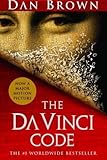 The Da Vinci Code
The Da Vinci Code
by Dan Brown
I’ve always considered it a crying shame most versions of Christianity are unable to tolerate any challenge to their theoretically monotheistic, hierarchical, all-male trinity. Consequently it does not surprise me in the least to find Mariolatry (or worship of Mary, the “virgin mother” of Christianity) was and still is ruthlessly stamped out by the Church every time it gains another foothold in the minds of the masses.
God forbid a woman, divine or otherwise, interrupt the sacerdotal monopoly the male Catholic clergy has on its people! (sacerdotalism: the belief that priests are necessary mediators between mankind and the deity/deities)
And yet, despite this violent and often bloody obliteration of so-called “heresy,” the overriding need for a Mother Goddess in Christianity keeps springing up again and again, over the years and centuries. Shouldn’t that tell the priesthood something?
The suppression of a female divine in Christianity is so consistently and thoroughly done, you can’t help but believe it must be deliberate. I believe we’ve lost something valuable in this process of religiously dehumanizing women, though, and I’m pleased to see that process apparently slowly reversing.
Which is not to say this reversal is occurring rapidly, easily, or without much fire and brimstone against it, of course. Still, at least it is finally, slowly happening.
Dan Brown’s book, The DaVinci Code, is a fine example of this meme almost sneakily re-inserting itself once again into both the consciousness of individuals and society’s dominant paradigm — along with all the horrified conservative nay-saying which follows behind it.
The Story
The story itself is a pleasure to read, quick-paced and absorbing. I do love a good, challenging puzzle, and considering most of the brainteasers concerned subjects I’d read extensively on, I was enormously gratified to be able to solve many of them well before the characters did.
Also, the linkage between historical elements and in-story riddles felt sound to me, as in the use of hidden messages through metaphor within paintings. I don’t know if the little puzzle boxes were indeed described by DaVinci, but they were a nice touch within the story.
Curiously, I found the murder mystery elements of the plot to be its weakest point. There was what I felt to be some poorly done obfuscation on Brown’s part in order to keep the identity of the Teacher secret just a little bit longer. Also, I was a bit uncomfortable with all the villains being somehow “abnormal” — Silas the huge albino, the obsessed and crippled Teabing, the violently allergic butler, and the faceless bureaucratic malignity of the reactionary Opus Dei.
On the other hand, I felt Brown’s handling of the Grail religious sect was masterful. Had a sex scene been inserted at the beginning of our introduction to Sophie’s past, many readers would have been turned off. However, Sophie’s violent reaction to discovering something theoretically too horrible to ever talk about becomes an incredible audience teaser, luring the fascinated reader along to find out just what caused such emotional trauma.
By the time all is revealed, the mind has conjured up far, far worse possibilities than what actually occurred. The discovery that she witnessed a deeply religious ritual, which happened to include sex and sexual symbolism, becomes “normal” and almost commonplace feeling. Indeed, a friend amusedly noted to me she was a bit surprised at the apparent naiveté of a modern college-aged French girl — surely Sophie should be a bit more experienced?

